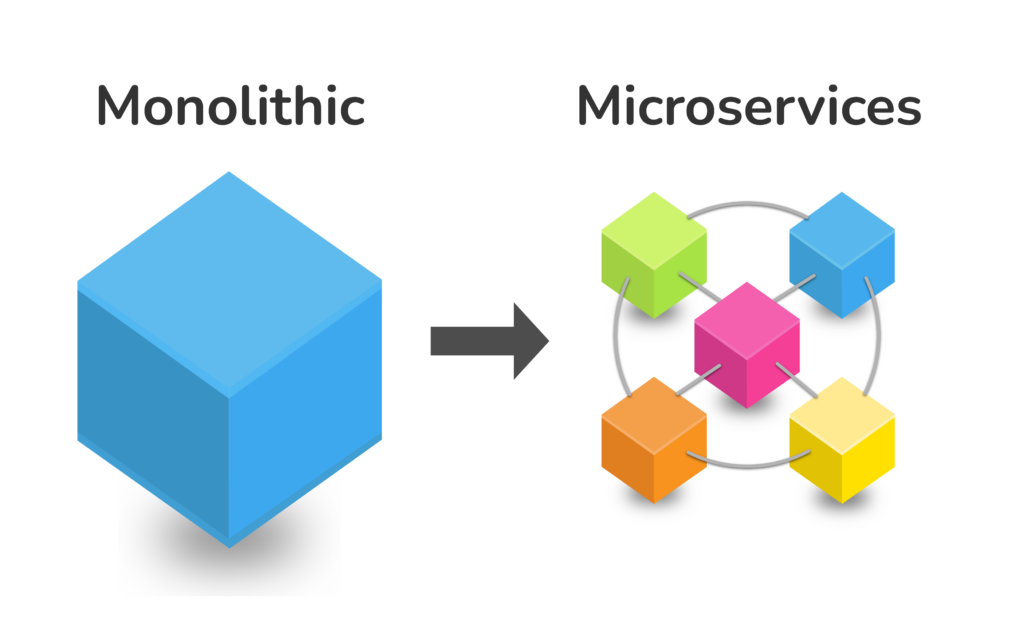Table of Content
- Enhancing Agility Through Independent Deployability
- Microservices Communication
- Microservices Communication Patterns and Styles
- Implementation Technologies–Protocols
- Stream Processing Solutions
- Deployment Techniques and Execution Environments for Microservices
- Challenges and Constraints of Microservices Architecture
- Benefits of Microservices Architecture
- Tools for Microservices Architecture
- Key Takeaway
Microservices architecture refers to a collection of networked services that deploy independently, provide functionality aligned with specific business capabilities, and enable flexible scalability. These loosely coupled server applications work in isolation and can be released on demand, allowing organizations to update and enhance individual components without disrupting the entire system.
By designing microservices with well-defined interfaces, companies can ensure that each service is both resilient and adaptable. Furthermore, aligning microservices with the organization’s business domains—often using domain-driven design (DDD)—ensures that technical solutions are tightly integrated with strategic business objectives. This approach not only improves operational agility and scalability but also drives digital transformation by enabling faster innovation, more responsive customer service, and a more resilient IT infrastructure.
Embracing microservices is critical in today’s fast-paced digital landscape because it transforms complex, monolithic systems into agile, modular solutions. This approach not only accelerates innovation and reduces downtime but also creates a more resilient IT infrastructure that can quickly adapt to market changes. The purpose of this paper is to demonstrate how implementing a microservices architecture can serve as a powerful lever for business transformation. By aligning technical solutions with strategic business goals, business leaders are empowered to streamline operations, enhance customer responsiveness, and drive sustained competitive advantage.
Enhancing Agility Through Independent Deployability
By separating business functionality and databases, you can deploy changes independently while ensuring compatibility with other components. This separation enables internal implementations to interact with multiple external interfaces simultaneously, accelerating product adaptation to user needs.
In a microservices architecture, you can modify individual business units without impacting the entire system—a stark contrast to the monolithic approach where all functionality is deployed together. Independent components, with clearly defined service boundaries, reduce the risk of widespread failures by isolating issues.
This architecture not only helps avoid vendor lock-in but also allows you to leverage diverse technology stacks to optimize performance. However, the flexibility and independence of microservices require careful management of service boundaries and communication protocols to maintain cohesion. Striking the right balance between coupling and information hiding ensures that changes to one service do not adversely affect others.
Furthermore, decomposing a system into smaller, self-contained services—each responsible for a specific domain—simplifies maintenance and accelerates development. As a technical partner, our role is to guide you through this process, from modeling inter-service relationships to implementing communication protocols, such as saga patterns with either choreography or orchestration approaches, to ensure a consistent and resilient microservices architecture.
In microservices, achieving flexibility and independent deployment comes at the cost of increased complexity in inter-service communication. Each service must define clear boundaries and protocols for interaction, striking a balance between coupling and information hiding. This means that while services remain loosely coupled—minimizing dependencies to reduce the risk of cascading failures—they also need well-defined interfaces to ensure seamless data exchange.
Understanding the nuances of these interactions, such as the trade-offs between synchronous and asynchronous communication, is crucial. For instance, excessive reliance on shared databases or synchronous calls can inadvertently increase coupling, undermining the benefits of a microservices architecture.
Our approach involves decomposing systems into self-contained units, each managing its own domain and communication channels, and using techniques to maintain consistency. This deeper look into the design and operational considerations helps technical teams better plan, implement, and scale microservices architectures in complex environments.
Microservices Communication
Microservices can communicate using various styles—or a combination of them—tailored to specific operational contexts such as latency, security, and payload volume. It’s important for business leaders and technical teams alike to evaluate the pros and cons of each communication style and technology.
At Krasamo, our teams create useful abstractions—like reducing payload sizes, implementing data serialization, and coding clear interfaces (method calls)—to simplify these interactions for both technical and business audiences.
Asynchronous Communication (Message Broker)
In asynchronous communication, a microservice sends a request as a message that is stored in a queue until it is processed. This decoupled approach allows services to handle multiple requests simultaneously, which improves scalability and enhances overall system flexibility. The method also enables improved fault tolerance since each request is processed independently once resources are available.
Synchronous Communication (Request–Response Calls)
Synchronous communication, by contrast, involves a direct, two-way exchange over a single network connection. While this method can be simpler for straightforward interactions, it carries the risk of overwhelming the system if too many connections are active at once—potentially leading to network congestion or failures. Therefore, careful design and management are essential to balance immediate responsiveness with overall system stability.
Microservices Communication Patterns and Styles
In a microservices architecture, different communication patterns are employed, each with unique benefits and trade-offs tailored to specific operational needs. One common approach is the request–response pattern, where a microservice sends a request to another service and waits for its response before proceeding. This model, which can be implemented either synchronously or asynchronously, is ideal for scenarios where immediate feedback is required—such as an authentication service verifying user credentials through an identity management service. However, it tends to introduce tighter coupling, as the requester depends on the availability and functionality of the responder.
Another prevalent pattern is the event-driven approach. In this asynchronous model, a microservice emits an event when a particular action occurs, and other services that subscribe to these events respond accordingly. This decoupled design enhances scalability and flexibility, since the emitter does not need to be aware of which service will process the event—illustrated by an order service that emits an “order placed” event to trigger inventory updates and notifications. Nonetheless, managing event flows and ensuring eventual consistency can add complexity to the system.
A third pattern involves exchanging data through a common repository, such as a filesystem or database—a method often used in data warehousing and data lake scenarios. This common data pattern is effective for processing large volumes of data and enables interoperability with legacy systems reliant on batch processing. Despite its capacity to handle extensive data, this approach poses challenges related to data consistency, security, and potential delays in data propagation.
Collectively, these communication patterns demonstrate the versatility of microservices design, where the choice of pattern depends on factors like response time requirements, scalability, data volume, and the degree of coupling desired. Understanding these trade-offs is crucial for selecting the optimal communication strategy to meet both business and technical objectives.
Implementation Technologies–Protocols
Implementing technologies for your microservices architecture requires careful consideration of compatibility and integration challenges. Our teams favor technology-agnostic solutions that enable flexibility and scalability, tailoring protocols and supporting tools to your specific needs.
It is important to note that all these higher-level technologies build upon the communication network protocols—TCP and UDP—that ensure reliable data transmission. Understanding these underlying protocols helps explain why we choose certain technologies to meet our performance, reliability, and scalability requirements.
Below, we outline key categories of implementation technologies, each with examples and an explanation of its role within the broader microservices ecosystem:
HTTP-Based APIs:
- Examples: REST (Microservices API), GraphQL, AsyncAPI
- Role: HTTP-based APIs are the backbone of web communication, allowing microservices to expose their functionality in a standardized, loosely coupled manner. They facilitate easy integration between services and external clients, making them ideal for widespread, internet-facing applications.
Remote Procedure Call (RPC) Protocols:
- Examples: gRPC, SOAP
- Role: RPC protocols enable one microservice to invoke methods on another as if calling a local function. They handle data serialization and deserialization efficiently, making them suitable for performance-critical interactions where binary protocols can reduce overhead.
Message Brokers (Middleware):
- Examples: Apache Kafka, MuleSoft AnyPoint Platform, RabbitMQ, Google Cloud Pub/Sub, AmazonMQ
- Role: Message brokers support asynchronous communication by handling event publishing and subscribing. They allow microservices to process large volumes of data in real time, enhancing scalability and decoupling services to improve fault tolerance and responsiveness.
Database Technologies:
- Examples: Apache Cassandra, MongoDB, ElasticSearch, Cloud SQL
- Role: In a microservices architecture, databases serve as persistent storage—an integral part of modern data systems—with each microservice often managing its own data store. This diversity supports various data needs—from high-performance transactional processing to advanced search and analytics—while maintaining service independence.
Filesystem Technology:
- Examples: Traditional file systems or cloud-based storage solutions
- Role: Filesystem-based solutions are useful for batch processing and for ensuring interoperability with legacy systems. They offer an alternative data exchange method when structured databases or real-time data streams are not required.
This structured approach to implementation technologies provides a clear understanding of how each category supports the microservices ecosystem, enabling organizations to design robust and flexible architectures that meet both technical and business requirements.
Stream Processing Solutions
Stream processing technologies are essential for handling real-time data streams and supporting event-driven architectures in microservices. These tools enable rapid processing and analysis of data as it is generated, which is crucial for applications that require immediate insights or actions. Consider the following technologies:
- Apache Flink: A framework for stateful computations over data streams, ideal for real-time analytics and complex event processing.
- Spring Framework: Provides support for building robust stream processing applications within the microservices ecosystem, leveraging Spring Cloud Stream for simplified integration.
- Debezium: An open-source platform for change data capture, enabling you to monitor and stream database changes in real time.
- Amazon Kinesis: A fully managed service that makes it easy to collect, process, and analyze real-time, streaming data for insights and responsive actions.
Deployment Techniques and Execution Environments for Microservices
Deploying microservices effectively requires leveraging modern technologies that optimize resource usage, ensure consistency, and support scalability. Key deployment techniques include:
Virtualization:
Microservices are often resource-intensive, making virtualization an important strategy. By running microservices on virtual machines, organizations can share physical hardware across multiple virtual environments, optimizing resource utilization and ensuring isolation.
Containerization:
Application containerization packages code along with all necessary dependencies, ensuring that applications run consistently across different environments. Containers are lighter than virtual machines, providing faster startup times and improved scalability.
Orchestration Platforms:
Managing containers at scale is best achieved using orchestration tools.
- Kubernetes: Widely recognized as the leading platform for managing containerized workloads, Kubernetes facilitates automated deployment, scaling, and management of microservices. Cloud-based services such as Azure Kubernetes Service (AKS) and Google Kubernetes Engine (GKE) further simplify these operations.
- Docker: As an open-source containerization platform, Docker is fundamental in developing, packaging, and running applications in isolated environments.
Microservices Frameworks (Spring Boot and Spring Cloud):
Microservices can also be built incrementally using frameworks like Spring Boot and Spring Cloud. Spring Boot’s embedded server model streamlines the development of microservices using the Java programming language, while Spring Cloud provides the necessary tools to manage inter-service communication and configuration.
Challenges and Constraints of Microservices Architecture
- Handling Network Failures:
In a distributed system, network failures are inevitable. Microservices must be designed to detect and recover from dropped connections, timeouts, or service unavailability. Implementing retry logic, circuit breakers, and fallback mechanisms helps ensure system resilience even when parts of the network fail. - Data Consistency Issues:
With multiple processes and databases in play, maintaining consistent data across services can be challenging. Techniques like eventual consistency, distributed transactions, or the use of saga patterns are essential to manage and reconcile data differences, ensuring that all services reflect an accurate state of the system. - Latency and Bandwidth Challenges:
As microservices communicate over the network, high bandwidth usage or inefficient data transfer protocols can introduce latency. This can slow down operations, so optimizing data payloads, using caching strategies, and selecting appropriate communication protocols are critical for minimizing delays. - Service Modeling:
Properly defining the boundaries and responsibilities of each microservice is key. Service modeling involves decomposing a monolithic application into smaller, manageable services that align with business domains. Poor service modeling can lead to over-coupled services or redundancy, so careful planning and iterative refinement are important. - Accessing Data for Reporting:
In a microservices ecosystem, data is often decentralized, making it difficult to compile a unified view for reporting. Strategies such as creating dedicated reporting services, data warehouses, or implementing event sourcing can help aggregate data for analytics without disrupting the transactional operations of individual services. - Troubleshooting and Debugging:
The distributed nature of microservices makes diagnosing problems more complex. Centralized logging, distributed tracing, and monitoring tools are essential to pinpoint issues across various services. These tools help trace a request’s journey through the system, facilitating faster troubleshooting and recovery. - Security of Microservices Endpoints:
Each microservice is a potential entry point for security threats. Ensuring secure communication through encryption, implementing proper authentication and authorization mechanisms, and regularly auditing service interactions are crucial for protecting the overall system from vulnerabilities. - Automated End-to-End Testing:
Testing in a microservices architecture is challenging due to the number of independent services and their interactions. Automated end-to-end testing frameworks help simulate real-world scenarios across multiple services, ensuring that changes in one service do not adversely affect the others. This also includes integration and contract testing to verify that service interfaces remain consistent. - Working in Unstable Business Domains:
When business requirements are rapidly changing or uncertain, the microservices architecture must be flexible enough to adapt. This instability can complicate service design and integration, requiring agile development practices and continuous refactoring to keep the system aligned with evolving business needs. - Managing Smaller Teams:
Microservices can introduce operational overhead, which might overwhelm smaller teams. It’s important to balance the architectural benefits with the available resources by leveraging automation, well-defined processes, and possibly consolidating services where appropriate to reduce management complexity. - Creating Network Interactions Between Services:
Efficiently managing network calls and ensuring that services interact seamlessly is vital. Excessive or poorly managed inter-service communication can lead to performance bottlenecks. Designing efficient APIs, using asynchronous communication when possible, and limiting the number of cross-service calls help mitigate these issues. - Aligning Organizational Structure with System Architecture:
For microservices to be truly effective, the organization’s structure should reflect the service boundaries. This alignment (often referred to as Conway’s Law) ensures that teams are responsible for distinct services, which facilitates better communication, accountability, and faster development cycles.
Benefits of Microservices Architecture
Microservices architecture offers numerous advantages that can significantly enhance both technical agility and business outcomes. By enabling independent deployment, microservices facilitate faster delivery of new features and updates, allowing organizations to respond quickly to market changes. This approach also empowers multiple developers to work independently and in parallel, improving overall productivity and accelerating development cycles. Additionally, scaling services on-demand—by only scaling specific components rather than an entire monolithic application—ensures more efficient use of resources.
Another major benefit is the ability to isolate failures; when one component fails, it doesn’t necessarily bring down the entire system, thereby enhancing overall system resilience. Microservices also allow organizations to embrace multiple technologies, meaning that different services can be built using the most appropriate language or framework for the task, rather than being constrained to a single technology stack. This flexibility supports high productivity by aligning team strengths with service requirements and allows for optimal team sizes where each team focuses on a specific service.
Furthermore, microservices promote the reuse of functionality across different parts of the organization, leading to more efficient development processes and faster innovation. Overall, these benefits combine to create a robust, adaptable, and scalable architecture that meets the demands of modern business environments.
Tools for Microservices Architecture
A successful microservices implementation depends not only on a solid understanding of business logic and physical architecture but also on robust operational support. Monitoring, logging, and tracing tools are essential to identify issues, maintain performance, and ensure overall system reliability. Below are some of the most recommended tools for solving operational problems in a microservices ecosystem:
Log Management & Aggregation:
These tools collect and aggregate application logs from multiple services into a centralized dashboard, making it easier to monitor system health and troubleshoot issues in real time.
- Cloud Logging
- Humio
- DataDog
- CloudWatch
Tracing & Analysis:
Distributed tracing tools help analyze the flow of requests across services, enabling you to pinpoint bottlenecks and understand inter-service interactions.
- Jaeger
- Lightstep
- Honeycomb
Public Cloud Computing
By integrating these tools into your microservices architecture, you can gain deeper insights into system performance, quickly detect and resolve issues, and ultimately support a more resilient and scalable application environment.
Cloud computing is a natural fit for microservices architecture, as it offers a flexible and scalable environment to deploy and manage a wide range of services. Cloud providers offer managed services for storage, databases, serverless computing, platforms, and message brokers that can simplify deployment and maintenance. This managed infrastructure allows organizations to focus on developing and innovating features, rather than managing hardware or software stacks.
Microservices thrive in the public cloud because of their technology-agnostic nature and ability to scale independently. A loosely coupled architecture, characteristic of microservices, benefits immensely from the cloud’s elasticity, enabling rapid scaling, improved resilience, and optimized resource usage. By leveraging cloud services, organizations can accelerate their digital transformation while maintaining the agility required to adapt to evolving business needs.
Key Takeaway
While implementing a microservices architecture may incur higher initial costs and slower progress, its long-term benefits—improved business functionality, enhanced agility, and increased profitability—make it a strategic investment. It is crucial to evaluate your current context, skillset, and available technologies before embarking on this journey. In the long run, microservices empower your organization to adapt to new technologies, vendors, and market demands with greater flexibility.
At Krasamo, our team can analyze your business challenges and tailor a microservices solution that minimizes risks. We advocate for an incremental migration from a monolithic architecture, ensuring that you can decompose your system effectively, set clear service boundaries, and manage changes smoothly. Our experts can help answer questions such as: What benefits can microservices bring to your enterprise? How should you approach system decomposition? What are the best strategies for handling change?
Remember, the goal isn’t always to migrate entirely to microservices but to find the most effective way to achieve your objectives. By aligning your teams, refining your organizational structure, and continuously fine-tuning your digital transformation strategy, you can harness the true power of microservices. Our teams are ready to translate your business vision into a robust, adaptable microservices system.












I get where you’re coming from, but I gotta respectfully disagree on the importance of circuit breakers in microservices communication! While they do help with fail-safing, a well-designed system can also utilize load balancing and service discovery to mitigate network failures. Plus, let’s not forget about implementing RESTful APIs for efficient data transfer protocols! A solid microservices architecture should balance both design patterns to ensure seamless communication between services.